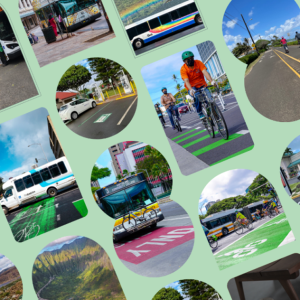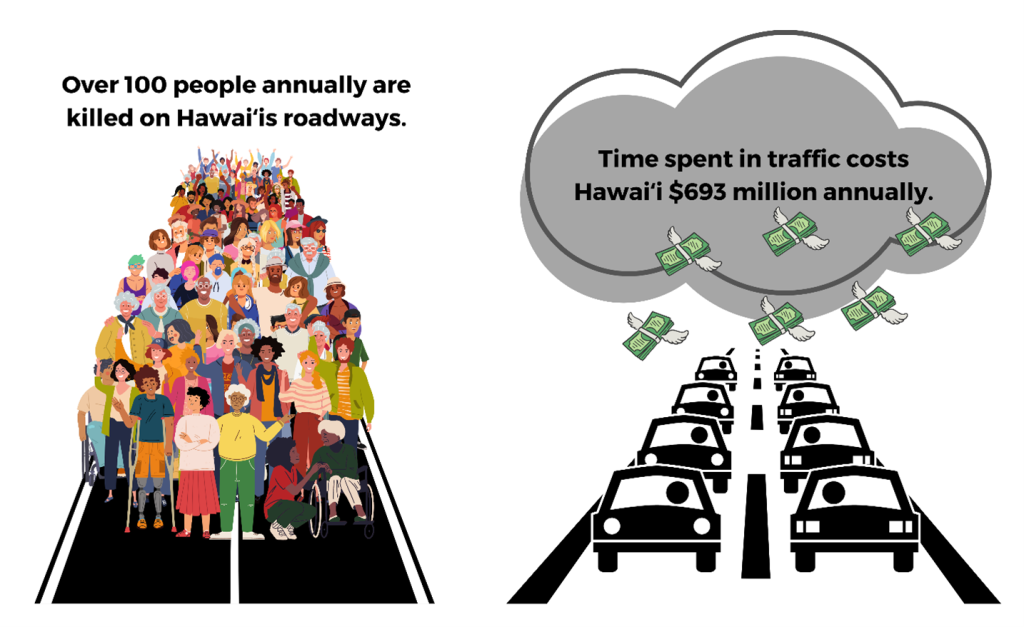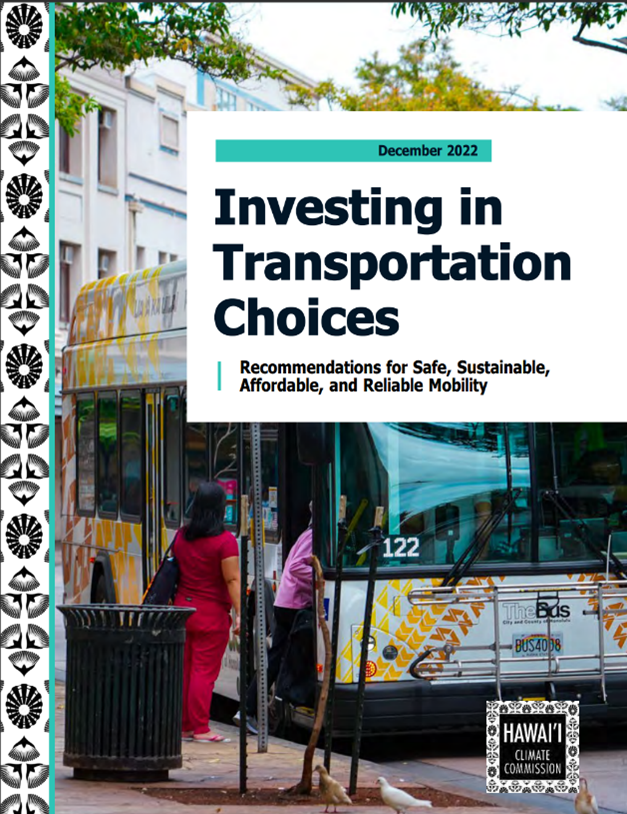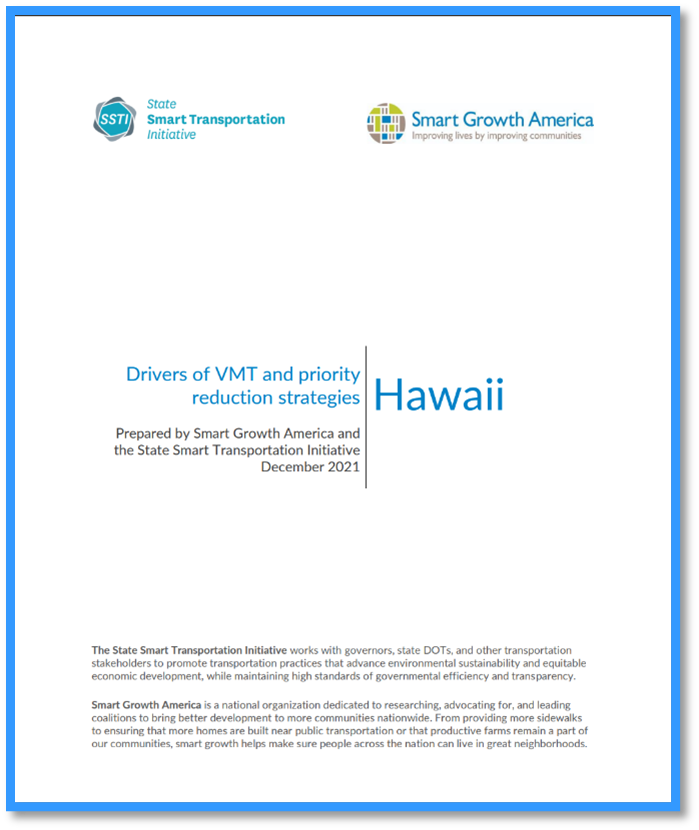- Home
- Critical Decade
- HI Climate Action
- HI Commission
- HI Resources
- HI Equity
- HI Events
Transportation Choices

Why we need better transportation choices?
Hawaiʻi’s transportation system and land-use is centered around travel made via cars. Non-vehicle transportation choices continue to be a making driving alone the preferred choice for many residents and visitors. Ground transportation is the largest source of transportation emissions. To reduce ground transportation emissions, Hawai‘i must invest in expanding safe, sustainable, affordable, and reliable transportation choices to support mobility that has low or no emissions.
Strategies to Reduce Transportation Emissions - Investing in Transportation Choices: Recommendations for Safe, Sustainable, Affordable, and Reliable Mobility
The Hawai‘i Climate Change Mitigation and Adaptation Commission’s Investing in Transportation Choices: Recommendations for Safe, Sustainable, Affordable, and Reliable Mobility, intends to inform decision-makers, government staff, citizens, and developers about the benefits of creating communities that support multimodal mobility and accessibility and empower them to take actions to reduce emissions across the state in support of achieving the State’s carbon net-negative goal by 2045. To the right are the seven recommendations from the report:
RECOMMENDATION #1: Develop and adopt a statewide VMT reduction target
RECOMMENDATION #2: Identify key state and county agencies to collaborate and coordinate on the implementation of VMT reduction policies, strategies, and programs
RECOMMENDATION #3: Ensure that state and county development plans associated with land use are designed to expand transportation choices
RECOMMENDATION #4: Develop and implement a strategy to integrate VMT into project-level analysis and decision-making for land use and transportation projects
RECOMMENDATION #5: Direct investments in transportation and land use towards projects that reduce the energy intensity of mobility through the expansion of transportation choices
RECOMMENDATION #6: Give people in Hawai‘i more safe, affordable, reliable, inviting, and convenient choices to get around by funding the completion of our pedestrian, bicycle, transit, and green networks
RECOMMENDATION #7: Create outreach products for the community on why expanding transportation choices is essential, how to achieve it, and the relationship between VMT-reduction policies, desired community outcomes, and state climate goal
What is VMT ?
VMT, or vehicle miles traveled is a proxy for measuring ground transportation emissions and the robustness of transportation options. VMT is a measure of vehicle travel generated within an area over a given period. In this way, VMT considers transportation and land use together. VMT in Hawai‘i has increased almost 40% over the last 25 years and is projected to continue to increase without intervention.
Reducing VMT improves health, environmental, and economic outcomes for everyone. VMT reduction is important as it serves multiple goals, including social equity, which is integral to Hawai‘i’s pursuit of a net-negative carbon economy. Vehicle dependency, congestion, collisions, and emissions burden communities with social, health, economic, and personal costs.


Over 100 people per year are killed in collisions on Hawai‘i’s roads and highways. Congestion costs the State of Hawai‘i $693 million annually, primarily through lost time and productivity from hours spent in traffic. The same study estimates the total public and private costs of the vehicle transportation system in Hawai‘i to be $21.8 billion annually. The personal annual cost of owning and operating a vehicle range from $8,000 to $10,000 a year for most U.S. drivers. Places where people must own and maintain a vehicle to conveniently access jobs and opportunities weigh down individuals and households with high transportation costs, particularly low-income households who must spend a greater percentage of household income on mobility than higher-income households.
VMT Data Report
Most states lack information about what factors are driving VMT growth, making it difficult to determine what level of VMT reduction is needed, what is achievable, and what strategies should be prioritized for the greatest impact. To help address this gap, the State Climate Commissions worked with the State Smart Transportation Initiative (SSTI) and Smart Growth America (SGA) to analyze and identify factors that have contributed to statewide VMT growth over the past decade and understand the role that VMT could play in achieving future clean energy goals.
The report provides an analysis of recent trends in VMT by road type, place type, and trip length to identify the key drivers of those trends. Based on the findings, the report also outlines key strategies that can be implemented at the state and local level to manage future VMT growth or lower VMT.
Key takeaways from this report include:
- Rural household car travel is growing the fastest – possibly due to an absence of robust transportation choices.
- Commercial activity travel, such as freight, tourism, and deliveries, account for 15% of VMT and are likely to grow.
- 70% of personal trips are under 5 miles and account for 15% of vehicles miles traveled – this means that many trips are ripe for new modes, if they are safe and accessible.
Although transportation choices may be different in different contexts, this work underscores several opportunities and bright spots in Hawai‘i. To read more of this report, click the graphic of the report.

